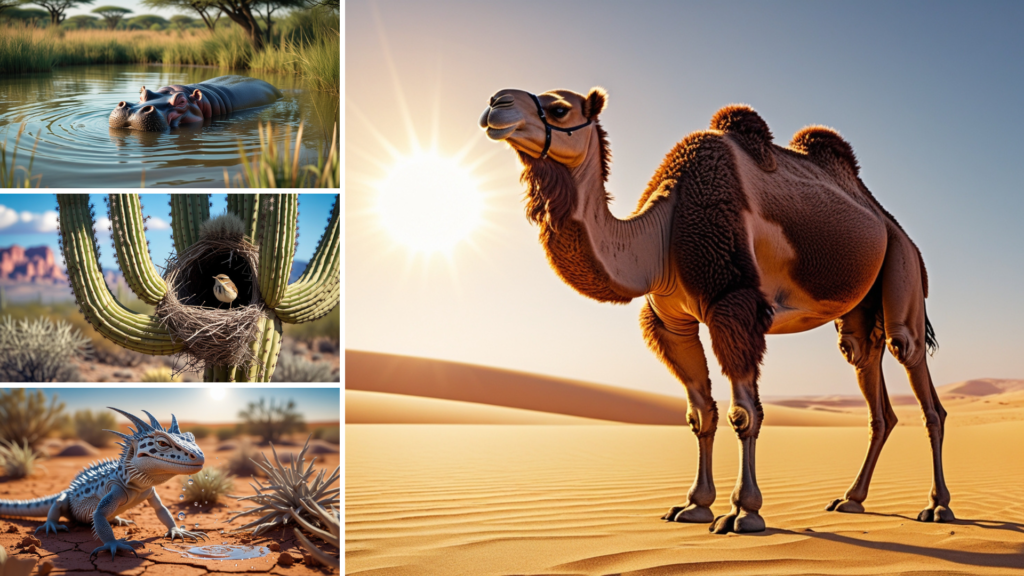When the summer sun blazes and the temperatures soar, humans can cool off with air conditioners, cold drinks, and swims. But what about animals? They don’t have ice cream trucks or sprinklers to run through, yet they’ve developed some truly incredible ways to stay cool and survive the heat. From clever behavior to unique body features, animals around the world show us just how creative nature can be when it comes to beating the heat.
Living in the Shade
One of the simplest ways animals stay cool is by avoiding the sun altogether. Many animals rest during the hottest part of the day and become active in the early morning or evening when it’s cooler. This behavior, called being crepuscular, is common among desert dwellers like coyotes, jackrabbits, and kangaroo rats.
Take the fennec fox, for example. Found in the Sahara Desert, this little fox spends most of its day resting in cool underground burrows. It comes out at night to hunt when the temperature is more bearable. By avoiding the sun, these animals conserve water and energy, making it easier to survive.
Fun Fact #1: Elephants use their large ears as built-in fans! By flapping them, they cool the blood flowing through the vessels in their ears, which helps lower their body temperature.
Dressing for the Weather
Some animals have physical adaptations that help them handle the heat. Camels, often called the ships of the desert, are experts at surviving extreme heat. Their thick fur might seem counterintuitive, but it actually protects them from the sun by creating a barrier between their skin and the scorching rays. Additionally, their bodies can withstand significant water loss, allowing them to go days without drinking.

Meanwhile, polar bears might live in cold climates, but their black skin under white fur is designed to absorb heat from the sun efficiently. In contrast, desert animals like the oryx have light-colored coats that reflect sunlight, helping them stay cool under the blazing sun.
Fun Fact #2: Kangaroos lick their forearms to cool off! Their saliva evaporates and carries heat away from their bodies, much like how sweating works for humans.
Sweating, Panting, and Cooling Off
Sweating is one of the most efficient ways to cool down, and many animals use this trick. Horses sweat just like humans do, while dogs rely on panting to release heat. Panting allows air to circulate over a dog’s tongue, which is full of blood vessels. As the air cools the blood, it helps lower the dog’s body temperature.
Birds, on the other hand, can’t sweat, so they use a process called gular fluttering. By rapidly vibrating the skin in their throats, they increase airflow and cool down. Roadrunners, famous for their speed, also use this technique to beat the heat of the desert.

Fun Fact #3: Hippos spend most of their day submerged in water, not just to cool off but also to protect their sensitive skin from the sun. They even produce a natural sunscreen – a reddish oily substance that acts as both a moisturizer and UV blocker!
Finding Natural Air Conditioning
For some animals, water is the key to staying cool. Crocodiles, for example, keep their bodies at the right temperature by basking in the sun to warm up and sliding into water to cool down. Similarly, amphibians like frogs rely on moist skin to regulate their body temperature. They often hide in damp, shaded areas during the day to avoid drying out.
Beavers take a different approach. By living in lodges surrounded by water, they have a built-in escape from the heat. Water not only cools them off but also provides protection from predators.
Fun Fact #4: The African bullfrog can bury itself underground and create a mucus cocoon to stay cool and retain moisture during the dry season. It emerges only when the rains return!
Smart Eating and Drinking Habits
Some animals adapt their eating and drinking habits to survive the summer heat. Giraffes get most of their water from the leaves they eat, reducing the need to drink frequently. This is especially useful in dry savannas where water is scarce.
Desert tortoises are also masters of water conservation. They store water in their bladders and can reabsorb it when needed. Meanwhile, some insects, like the Namib Desert beetle, collect water from morning dew on their bodies, directing it straight to their mouths.
Fun Fact #5: Cactus wrens build their nests in the shady parts of cacti, using the plant’s natural structure to keep cool while protecting themselves from predators.

Keeping Cool Under Pressure

Some animals have evolved extreme measures to handle heat. The desert lizard known as the thorny devil absorbs moisture through its skin. Even the tiniest droplets of water can be channeled across its body to its mouth for drinking. This remarkable ability allows it to survive in one of the driest environments on Earth.
Other animals, like the Saharan silver ant, take advantage of their reflective bodies to stay cool. These ants venture out only during the hottest part of the day when predators are too overheated to hunt. By using the heat to their advantage, they avoid becoming someone else’s meal.
Final Thoughts
The animal kingdom is full of clever, inspiring, and sometimes bizarre solutions to summer’s challenges. Whether it’s by seeking shade, changing their habits, or relying on incredible physical adaptations, animals show us just how resourceful nature can be. Next time you’re enjoying a cool drink or sitting in the shade, think about the amazing creatures out there that have to survive without these luxuries. Their ingenuity is a reminder of how life finds a way, no matter how hot it gets!



